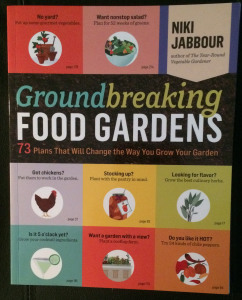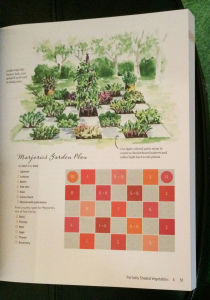 Edible gardening is one of the hot trends in horticulture and landscape design but it is not as easy as one would think. Niki Jabbour, in Groundbreaking Food Gardens: 73 Plans That Will Change the Way You Grow Your Garden, has gathered designs from many professionals in the green industry but also calls on her own experience as a Canadian gardener who produces food for her family, even in winter.
Edible gardening is one of the hot trends in horticulture and landscape design but it is not as easy as one would think. Niki Jabbour, in Groundbreaking Food Gardens: 73 Plans That Will Change the Way You Grow Your Garden, has gathered designs from many professionals in the green industry but also calls on her own experience as a Canadian gardener who produces food for her family, even in winter.
Before implementing any of these plans, the author has some tips for getting the most out of these gardens and selecting which plants to grow.
There is a wide variety of plans ranging in size, shape, style, and location, including front yards and balconies, gardens and containers. Each design has a theme. Many of these gardens not only produce food; they also contribute to the health and population of pollinators and other beneficial insects. I’ve always pinched off basil flowers in order to maximize the foliage without realizing that these flowers attract bees. From now on, I’ll have to leave some for the bees.
The diversity of the plans is astonishing, even including one for those who also want to raise chickens. It comes with a warning about plants not to grow because they are toxic to chickens. Edible gardening in deer country is definitely a challenge but there are plans to make it possible. They do include fencing but evidently a double fence of five feet each is just as effective as one eight foot fence. The other big edible gardening challenge is shade and there are two plans for shade, one with a lovely checkerboard plan as well as some suggestions for maximizing the amount of light.
Many of the plans stress verticality as a means of maximizing space and light. While edible gardening can be an expensive undertaking, the book is full of ideas for using inexpensive materials in creative ways.
For those who want to grow edibles in the front yard because it’s the only place with enough sun, the key is making the gardens attractive and inviting. A colorful, sunburst patterned design is edged with old fashioned (smelly) marigolds to deter rabbits which are one of the banes of edible gardeners. I only wish that there had been a photograph of this garden. That is the only fault I find with this book. The colored designs are attractive but photographs would make it easier for non-visual people to perceive the reality of such designs. The lack of photographs is mitigated somewhat by occasional sketches.
Whether you’re designing a edible garden for a client or for yourself, this book is a treasure trove of ideas.
Jabbour, Niki, Groundbreaking Food Gardens: 73 Plans That Will Change the Way You Grow Your Garden, Storey Publishing, 2014, $19.95.



0 Comments